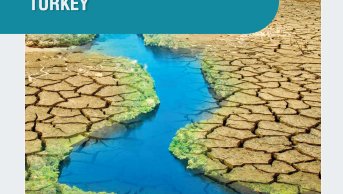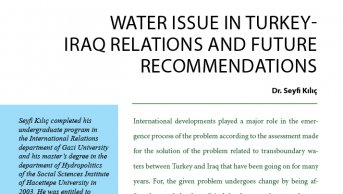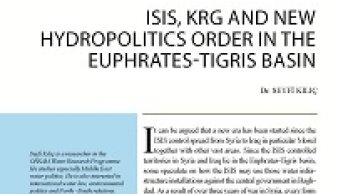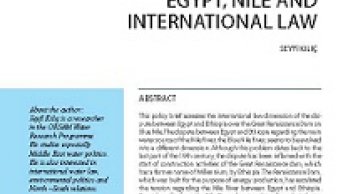An Assessment of Water Cooperation Between Israel-Jordan-Palestine
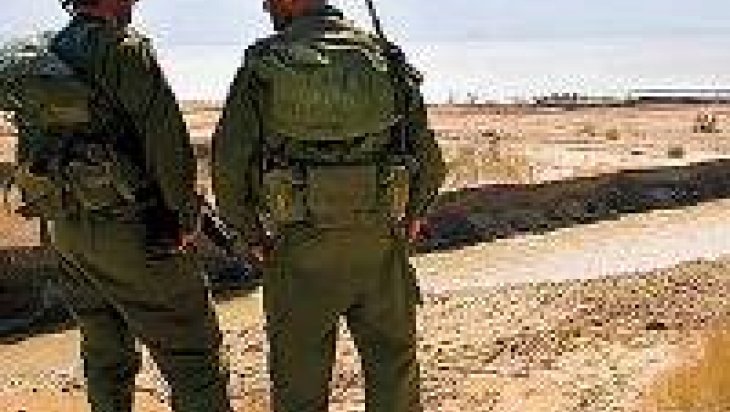
The Dead Sea, the lowest point on the land surface of the earth, is rapidly drying up due to excessive use of the Jordan River, the main water resource flowing into the Dead Sea.
The Jordan River has an important place in international water politics and international politics despite the small amount of water it discharges. Its basin countries are Jordan, Israel, Syria, Lebanon and Palestine. It is the main surface water resource for Israel and Jordan. Palestinians, on the other hand, do not currently consume water from this resource.
A plan to save the Dead Sea, whose level has been falling at a rate of around three meters per year, has been on the agenda, especially since the 1990s. One leading project, the Red Sea-Dead Sea Conduit (Canal), is in progress. Although some projects aim to generate electricity by taking advantage of the height difference between the Dead Sea and the Red Sea, there is no such goal in the current project, at least for now. It is envisaged as an additional water supply for Jordan and Israel via a desalination plant to be constructed in Aqaba, Jordan, and the project will be financed by the World Bank. Meanwhile, the Palestinian Authority (PA) will buy 20-30 million cubic meters per year in additional desalinated water from Israeli water company Mekorot, as the parties have agreed in a memorandum of understanding (MoU).
In addition to the MoU's great importance for relations between the three countries, it is also necessary to determine Palestine's situation under Israeli occupation and see what kind of obstacles this poses for the social and economic development of Palestine. Water resources in Palestine are becoming scarce due to overpopulation and pollution caused by insufficient sanitation services, as in other underdeveloped countries. This situation damages water quality and leads to water scarcity, as well as causing conflict between domestic, industrial and agricultural water uses. However, Palestine has one feature that distinguishes it from other underdeveloped countries. In terms of the pre-1967 borders of Palestine, it has been under Israeli occupation since that time, and in addition to the water scarcity stemming from geographic and climatic conditions, it also faces a water shortage caused by political factors. Another point that should be highlighted here is that it is not unusual to read or hear about Israeli settlements in the West Bank discharging their waste water intentionally onto Palestinian land.
The Israeli occupation of the West Bank makes it possible for Israel to unilaterally draw ground water in the area. The occupation of the West Bank prevents Palestinians from using the ground water resources in the area. Israel has been systematically damaging the wells belonging to Palestinians in the West Bank since its 1967 occupation of the land. Permission from the Israeli military authorities is required before drilling a well in this area. Also, prolonged water cuts in Palestinian settlements are not unusual. Moreover, Israel illegally pursues its occupation through Israeli settlements in the West Bank and East Jerusalem.
Israeli settlers in the West Bank and East Jerusalem pay one-third of the price paid by Palestinians for domestic water and one-tenth of the price for irrigational use. The annual amount of water consumed by an Israeli settler in the West Bank is seven times more than a Palestinian's. Before the settlers were evacuated in 2005, the figure for Israelis in the Gaza Strip was 13 times more than for Palestinians. Interpreting the situation without taking these figures into consideration would be to ignore the facts.
The MoU was signed in Washington at the World Bank headquarters on Dec. 9, 2013. The project aims not only to provide drinking water but also to maintain the ecological balance in the region. However, there are still certain problems in terms of the environment. It has been suggested that the ecological balance and ground water resources in the region will be damaged by the project.
If further negotiations are launched, the MoU's most important achievement for all three countries will be its promotion of common interests by putting political disputes, especially on water, aside. Also, it is easier to reach an agreement between the parties with the presence of an organization or mediator such as the World Bank, which is capable of mobilizing major financial power and which actively participates in negotiations. From a historical viewpoint, furthermore, it is known that the World Bank played an active role in solving the conflict between India and Pakistan.
However, the MoU avoids the term “water conflict,” which has been mentioned in the context of water scarcity for many years. This avoidance makes the agreement meaningless, as one of the parties is still under occupation -- Palestine -- and the other is the occupying state -- Israel. It would be a more realistic approach to consider the MoU a significant step in terms of the development of cooperation. Under the agreement, Israel will also provide Amman, the Jordanian capital, with 30-45 million cubic meters of fresh water from the Sea of Galilee. The Jordan River is considered to have two parts: The upper part of the river covers the area from the source to the Sea of Galilee, and the lower side of the river covers the area from the Sea of Galilee to the Dead Sea. In negotiations held between Israel and Jordan in previous years, Israel had stated that Jordan is a riparian state only to the lower Jordan River, rejecting Jordan's water demand from the Sea of Galilee. This attitude, which does not make hydrological sense, was maintained by Israel for many years.
The MoU shows that Israel's long-term policy of ignoring Jordan's demands about the Jordan River's upper parts has changed. The change in this agreement is considered a significant result.

